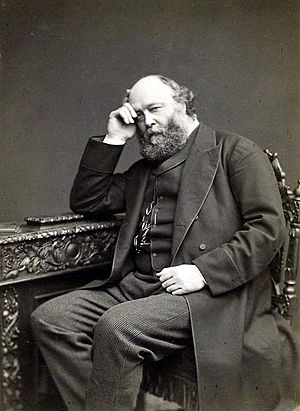1892 vote of no confidence in the Salisbury ministry facts for kids
Imagine a team playing a game, but they don't have enough players on their side to win. That's a bit like what happened in 1892 in the British Parliament. The government, led by Lord Salisbury, was from the Conservative Party. Even though they didn't win enough seats in the election to have a clear majority, they decided to meet Parliament anyway.
When Parliament met, the government presented a "Queen's Speech," which is like their plan for what they want to do. But the other main party, the Liberal Party, led by William Ewart Gladstone, didn't agree. They proposed a special vote called a vote of no confidence. This vote meant that the Members of Parliament (MPs) would decide if they still trusted the current government. On August 11, 1892, the House of Commons voted 350 to 310 against Lord Salisbury's government. Because they lost this important vote, Lord Salisbury had to resign. Then, William Ewart Gladstone became Prime Minister for the fourth time!
Contents
Why the Government Faced a Vote
After the general election, people watched closely to see which party had won the most seats. In the old Parliament, the Conservatives and their allies, the Liberal Unionists, had a good lead. To win, the Liberal Party and their allies needed to gain at least 33 more seats.
As the election results came in, the Liberals made big gains. By July 12, they had gained 36 seats! This meant that the Liberals and their allies, including some Irish Nationalist MPs, now had more seats than the Conservatives and Liberal Unionists combined.
Even with all the results known, the Liberal Party didn't have enough seats to win on their own. They needed the support of other groups, especially the Irish Nationalist MPs. Because of this, Lord Salisbury, the Prime Minister, didn't resign right away. He wanted to see if he could still lead the country.
The Liberal leader, William Gladstone, met with some Irish leaders. They all agreed that the "no confidence" vote should happen quickly. The Irish MPs, even though they wanted to stay independent, planned to support the motion against the government.
Parliament Begins Its Work
On August 4, the new Parliament met. The first thing they did was choose a Speaker. The Speaker is like the referee of the House of Commons, making sure everyone follows the rules. Sir Arthur Peel, who had been Speaker for eight years, was chosen again by everyone.
A few days later, on August 8, the Queen's Speech was delivered. This speech is usually read by the Queen, but sometimes, like this time, it's read by other important people. The speech was very short and didn't say much about new plans. It mostly just said that the old Parliament had finished its work.
The No Confidence Vote Begins
Later that day, the House of Commons started debating the Queen's Speech. Two Conservative MPs thanked the Queen for the speech. One of them, Dunbar Barton, mentioned that some people thought Lord Salisbury should have resigned earlier. He also defended the government's plans for Ireland.
Then, a Liberal MP named H. H. Asquith proposed an important change to the speech. He wanted to add words that said:
We believe it's important that Your Majesty's Government has the trust of this House and the Country. We respectfully tell Your Majesty that the current people advising you do not have that trust.
This change was really a way to say, "We don't trust this government anymore!" The debate about this change lasted for three full days: Monday, August 8; Tuesday, August 9; and Thursday, August 11. The House didn't meet on Wednesday to prepare for the big vote.
The Big Vote Happens
The final vote happened at midnight on August 11. It was a very exciting moment! So many MPs voted that it took more than 25 minutes to count all the votes. Both the Conservative leader, Arthur Balfour, and the Liberal leader, William Gladstone, were cheered loudly by their supporters. Gladstone's supporters even waved their hats!
The results were announced by Liberal MP Arnold Morley:
| Yes votes | 350 |
|---|---|
| No votes | 310 |
The announcement led to even more cheers! This vote was very important because it was one of the biggest votes ever in the House of Commons. Almost all 670 MPs were there. Only a few were absent, either because they were ill or out of the country.
A New Government Takes Over
After losing the vote, Lord Salisbury traveled to Osborne House on the Isle of Wight to meet Queen Victoria. He told her he was resigning as Prime Minister. The Queen accepted his resignation, saying she was sad to see him go.
Two days later, on August 15, William Gladstone arrived to meet the Queen. He officially took over as Prime Minister for the fourth time in his long career. This showed how important the "no confidence" vote was in changing the leadership of the country.


